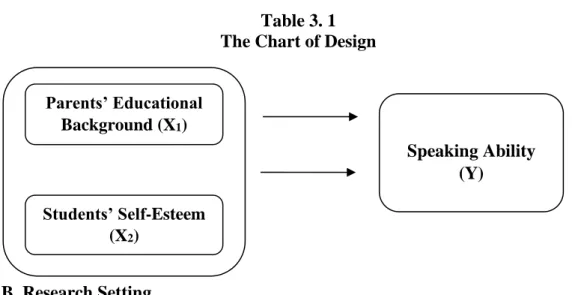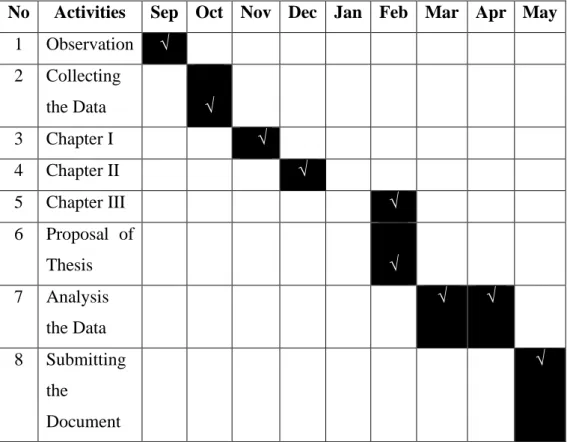INTRODUCTION
Background of the Study
Identification of the Problem
Many students are not enthusiastic about speaking because of limited vocabulary, difficult grammar and pronunciation. Speaking skill is still a problem for students because of their belief that speaking is the most difficult skill to learn English.
Limitation of the Problem
Formulation of the Problem
Objective of the Study
Benefits of the Study
To determine whether there is a positive and significant correlation between the educational background of the parents and the self-esteem of the students in terms of speaking skills in the tenth grade students of SMAN 1 Ceper in academic year 2022/2023. The results of this study are expected to inform and help English teachers improve students' speaking skills by knowing that students' self-esteem and parents' educational backgrounds can also influence students' improvement.
Definition of the Key Terms
Several researchers have investigated the correlation between parents' educational background and students' self-esteem with regard to speaking skills. In this correlation study, the aim was to find a correlation between the educational background of the parents (X1) and the self-esteem of the students (X2) with regard to speaking ability (Y). The questionnaire conducted in this study was used to determine the educational background of the parents and the self-esteem of the students.
For the questionnaire, the researcher used to find out parents' educational background and students' self-esteem. This can be interpreted as the direction of influence of parents' educational background (X1) and students' self-esteem (X2) towards speaking ability (Y) is positive. d. Table 4.18 shows the results of the significant regression test between parents' educational background (X1), students' self-esteem (X2) and speaking ability (Y).
The coefficient of determination in the table above shows that the result between the educational background of the parents (X1) and the self-esteem of the students (X2) with regard to speaking skills (Y) is 0.878. Third, the third hypothesis test showed that there was a positive and significant correlation between the educational background of the parents (X1) and the self-esteem of the students (X2) with regard to speaking ability (Y). The coefficient of determination in the above table shows the result between the educational background of the parents (X1) and the self-esteem of the students (X2).
From the results of the hypothesis test, there is a positive and significant correlation between parents' educational background and students' self-esteem. It can be concluded that parents' educational background and students' self-esteem can be a factor that affects students' speaking ability.

LITERATURE REVIEW
Theoretical Review
- Review on Speaking Ability
- Review on Students' Self-Esteem
- Review on Parents' Educational Background
Previous Related Studies
The results of this study indicate that there is a significant correlation between self-esteem and gender on speaking skills. The focus of previous research included only two variables, namely self-esteem and speaking ability, while this study included three variables, namely parents' educational background. students' self-esteem and speaking ability.
Rationale
Hypothesis
24 The results of correlation Pearson Between parents' educational background (X1) and students' self-esteem (X2) against speaking ability (Y).
RESEARCH METHODOLOGY
Research Design
Research Setting
The researcher decided to use the Merdeka curriculum app to find schools that teach speaking and have students with different speaking abilities, and the diversity of speaking skills is very visible in every class.
Population, Sampling and Sample
The population in this research is all students of the tenth grade of SMAN 1 Ceper in the academic year 2022/2023. The subset of the population selected for use in the study is the meaning of the sample. So that the population of this study can be represented by the sample.
According to Sugiyon (2016), probability sampling means that each member of the population has an equal chance of being sampled in a survey. Cluster random sampling is done by randomly selecting several population groups, in cluster sampling each cluster has an equal chance of being the sample of this study. The sample determination step in this study was randomly selected using a spinner application consisting of classes A, C, D, E, F and G.
In this study, researchers used two classes, namely C and D to represent the population of all tenth grade students at SMAN 1 Ceper. The sample in this study therefore met the research sample requirements in the form of correlation.
Techniques of Collecting the Data
According to Ary et al., (2010), cluster random sampling is a random sampling technique from a population consisting of several groups or clumps. This oral test is done by asking the students to speak in dialogue in front of the class according to the topic given by the researcher. In this case, the test was conducted to test and find out each student's speaking ability based on the dialogue that was conducted.
In this questionnaire, students are only asked to select the last education possessed by each student's parents. Each questionnaire for fathers and mothers has the same number of choices, namely nine choices according to Janke et al., (2017). The researcher determines the points for each level of education based on the years taken at each level.
Second, for the students' self-assessment questionnaires, the researcher used a questionnaire and the questionnaire used was a closed-ended questionnaire. The self-assessment question used by the examiner used a self-assessment question indicator from Plummer (2005).
Research Instrument
Data Validation
The validity of the parents' educational background instrument and the validity of the speaking test instrument in this study, the researcher used content that went through a review process and was determined from the material taught by the teacher, where the content of the instrument would be adjusted according to the material. Therefore, the researcher must adapt the content of the instrument to the material based on the telling indicators in the blueprint. In this study, the reliability test for parents' educational background and students' self-esteem used Cronbach's Alpha using SPSS 24.
According to Sujarwena (2016), a questionnaire can be said to be reliable if it has a Cronbach's alpha value > 0.6. Based on the calculation of the reliability of the student self-image questionnaire according to the Alpha Cronbach formula with the SPSS 24 program, it calculates 0.796. In order to determine the reliability of the speaking test, the researcher used the principle of interrater reliability.
In recognizing speaking ability using a speaking test, the researcher will use the students' dialogue in front of the class on the topic given by the researcher. In each dialogue in front of the class, two people who have good skills in Reliability Statistics.
Techniques of Analyzing the Data
This can be interpreted as the direction of influence of students' self-esteem (X2) against speaking ability (Y) being positive. 3) Regression parents' educational background (X1), self-esteem (X2) and speaking ability (Y). So the correlation between parents' educational background (X1) and speaking ability (Y) has a very high degree of correlation. The coefficient of determination in the table above shows the result between the parents' educational background (X1) and the students'.
This theory supports the results of the first hypothesis that there is a positive and significant correlation between parents' educational background and speaking ability. The results of the second hypothesis test conducted by the researcher showed that there was a positive and significant correlation between students' self-esteem (X2) and speaking ability (Y). The results of the third hypothesis test carried out by the researcher showed that there was a positive and significant correlation between parents' educational background (X1) and students' self-esteem (X2) regarding speaking ability (Y).
It can be assumed that there are two factors that can influence speaking ability, namely the parents' educational background and the students' self-esteem.
RESEARCH FINDING AND DISSCUSSION
Research Finding
- Data Description
- Data Analysis
Discussion
The researcher analyzed the data from the parents' educational background questionnaire and the students' self-esteem questionnaire as well as the speaking ability test of the tenth grade students of SMAN 1 Ceper. The analysis in this study which is contained in the problem formulation is to determine the correlation between parents' educational background and students' self-esteem regarding speaking ability in the tenth grade of SMAN 1 Ceper in the academic year 2022/2023. The coefficient of determination in the table above shows the result between students' self-esteem (X2) and speaking ability (Y) is 0.851.
So it can be said that the theory supports the results of the second hypothesis that there is a positive and significant correlation between students' self-esteem and speaking ability. So the correlation between parents' educational background (X1) and students' self-esteem (X2) in relation to speaking ability (Y) in tenth grade in SMAN 1 Ceper in the academic year 2022/2023 has a very high degree of correlation. Based on the two tests carried out in the hypothesis, the results show that there is a positive and significant correlation between parents' educational background and students' self-esteem against speaking ability at tenth grade in SMAN 1 Ceper in the academic year 2022/2023.
Second, the second hypothesis test showed that there was a positive and significant correlation between students' self-esteem (X2) and speaking ability. So, the correlation between parents' educational background (X1) and students' self-esteem (X2) towards speaking ability (Y) in the tenth grade of SMAN 1 Ceper in the academic year 2022/2023 has a very high level of correlation. A study on parents' educational background and students' self-esteem towards speaking ability among eighth grade students of MTS Sambirejo Sragen in the academic year 2018/2019.
Correlation between students' self-esteem and their speaking ability in Junior High School 10 Tapung Kampar Regency.
CONCLUSION AND SUGGESTIONS
Conclusion
Suggestions
So teachers can improve teaching to improve speaking ability to help improve students' oral communication, students can do their best. So that students' speaking ability should be improved and developed to create good communication in English. Self-Perception Self-Esteem Physical Activity and Sedentary Behavior of Elementary Greek School Students: A Pilot Study.
Influence of Parental Involvement on Students' Academic Performance in Public Mixed Day Secondary Schools in Kuresoi Sub-County, Nakuru County, Kenya. The relationship between parents' educational background and students' motivation to learn English at Muhammadiyah 2 Vocational High School Pekanbaru. The correlation between parental educational level and students' English learning achievement (A Study of Eleventh Grade Students' at SMK Negeri 2 Sungguminasa Gowa).
Correlation between self-esteem and speaking ability of tenth grade students in SMKN 03 Kotabumi in the academic year 2020/2021. Correlation of parents' educational level and students' English academic achievement (a study of eleventh grade students at SMK Negeri 2 Sungguminas).
